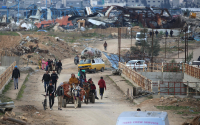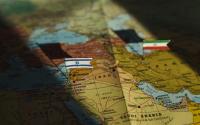23 December 2005The Sydney Morning Herald
"The sea has its own ways. We can't control it," says Chief Reuben Selwyn as he stands on a thin wall of coral which is all that now separates his little village from the invading sea.
The destiny of Tegua island, home to 64 people in the remote Torres group of islands in far north Vanuatu, has always rested on the sea.
The sea brought its first settlers at least 3000 years ago on bamboo rafts, its raiding enemies from nearby islands, the first beche-de-mer traders from Europe, "blackbirders" and Anglican missionaries.
It brings bright rainbow-coloured reef fish and leatherback turtles, who build nests along a windswept coast, as well as colonies of football-sized coconut crabs, prized by the restaurants of the Vanuatuan capital of Port Vila.
But for some years, the sea has been literally eating away this pristine coral island.
Chief Reuben, paramount head of the island and father of six boys and six girls, claims that at least once a year a combination of king tides and a surging sea whipped up by strong winds floods his village of Loteu. He remembers as a young boy he could walk 30 metres from his house and fish from a rocky beach platform. Now the platform is submerged and he has been forced to abandon his childhood home.
"I'd say the sea has come up 10 or 20 metres [horizontally] since I was a boy," he says. "I can't say if it's because of humans or because nature has its own power. But for us here we have no choice; early next year we will move into a new village further inland."
A world away in Montreal, Canada, scientists have been attending a major conference on climate change and the human cost of rising sea levels.
The scientific panel advising the UN Environment Program believes seas could rise by up to a metre by 2100 because of melting polar icecaps and warmer temperatures linked to burning fossil fuels and the industrial emission of greenhouse gasses.
"The peoples of the Arctic and the small islands of this world face many of the same threats," says Klaus Toepfer, the executive director of the United Nations Environment Program.
"The melting and receding of sea ice and the rising of sea levels, storm surges and the like are the first manifestations of big changes under way which eventually will touch everyone on the planet."
A Pacific island delegate at the 189-nation conference, Taito Nakalevu, says king tides are flooding islands across his region.
Pacific islanders living on low-lying coral atolls are among those seriously at risk. Two uninhabited Kiribati islands disappeared in 1999. Tuvalu has approached Australia and New Zealand to resettle its entire population when its islands are expected to go underwater within the next 30 years.
Meanwhile, 2000 people living on the Carteret islands in Papua New Guinea are preparing to move to nearby Bougainville island, a four-hour boat ride to the south-west.
One Carteret islander told Radio Australia recently that they were only waiting on finance from the government to help them move. Their health has been steadily deteriorating because they are losing access to fresh water, and gardens are being destroyed by advancing salt water. On Tegua, Chief Reuben claims the same problems have beset his community.
"Look at that line of coconut trees over there," he says, sweeping his arm towards white sandy beaches 500 metres away. "The advancing salt water is killing our coastal coconut trees. Before, those trees were behind the beach, but now they are right at the water's edge. So we have to plant new trees and new gardens further inland."
Memories are still fresh of a tsunami that hit Tegua and nearby islands in 1998. The wave hit at 11pm, when most people were in bed, and terrified villagers woke to waist-high water streaming into their huts. They fled to a cave on high ground they have used as a refuge when cyclones hit.
The biggest problem for Tegua islanders has been the lack of fresh water. There are no rivers or creeks, so they relied on two small freshwater springs. One has dried up and the other is covered by the sea. For the past decade or more, islanders have had to rely on rainwater they get for six months of the year during the wet season brought on by the trade winds.
For the other six months there is only what water they have saved in small plastic containers as well as that island saviour, coconuts.
But now a group of local and international agencies have come to Tegua's aid.
In what is being touted as a first, the Canadian Government, in partnership with the South Pacific Regional Environment Program and the UN, have provided funds for the relocation of Chief Reuben's village and a water-catchment area. It is claimed to be the first time donor agencies have fully funded such a program as a consequence of global warming.
The Tegua relocation program began in 2002. The program is involved in the Cook islands, Fiji, Samoa and Vanuatu.
"Vanuatu is the first country to relocate a settlement as well as build a water-catchment area," said the Vanuatu Government's National Advisory Committee for Climate Change co-ordinator, Brian Phillips.
Tegua's new village, half a kilometre inland, has seven simple wooden houses with sloping roofs draining into 6000-litre water tanks imported from Australia.
Chief Reuben, barefoot and accompanied by one of his sons, Aiden, is surprised but thankful that his community was chosen first.
"There's room here for our five families and a rest house for visitors. I think our water problems are over now. We plan to move into our new homes in January or February."
Many Pacific islands are part of the Pacific Rim of Fire where volcanic activity and earthquakes are frequent. Some geographers have pointed out that some islands get tilted because of seismic activity, leading to part of an island dipping into the sea.
Pacific islanders have always been resourceful, used to adapting quickly to a changing environment.
In a curious cycle of history, some islanders, like those on Tegua, are going back to an older pattern of life and settlement that existed before the Europeans came.
As Francis Hickey, a marine ethnographer who specialises in traditional island conservation methods at the Vanuatu Cultural Centre, explains: "Before the arrival of the Europeans, most Pacific islanders tended to live quite a way inland away from the immediate coast.
"This protected them from strong winds and surging seas, as well as raiding parties. … As the first whalers, missionaries, traders and planters came, they lured people from the bush down to the coast to trade, convert and be protected from tribal war."
When Captain Cook sailed through the Torres islands, he stopped and apparently came ashore on Tegua.
Chief Reuben tells the story over a shell of kava as his sons prepare the muddy drink by chewing and then spitting little lumps of fibre into a bowl.
Captain Cook asked what the islanders called their home and was told "Tuya", which translates as "hill or mountain", since it is one of the few islands in the Torres chain which has a ridge rising at least 300 metres above sea level.
"Not for the first time, the word got lost in translation and the anglicised version, Tegua, remains.
Yet it may be that the original name, Tuya, will prove providential: that hill may be the one thing that saves Chief Reuben and his community.
Meanwhile, 2000 people living on the Carteret islands in Papua New Guinea are preparing to move to nearby Bougainville island, a four-hour boat ride to the south-west.
One Carteret islander told Radio Australia recently that they were only waiting on finance from the government to help them move. Their health has been steadily deteriorating because they are losing access to fresh water, and gardens are being destroyed by advancing salt water. On Tegua, Chief Reuben claims the same problems have beset his community.
"Look at that line of coconut trees over there," he says, sweeping his arm towards white sandy beaches 500 metres away. "The advancing salt water is killing our coastal coconut trees. Before, those trees were behind the beach, but now they are right at the water's edge. So we have to plant new trees and new gardens further inland."
Memories are still fresh of a tsunami that hit Tegua and nearby islands in 1998. The wave hit at 11pm, when most people were in bed, and terrified villagers woke to waist-high water streaming into their huts. They fled to a cave on high ground they have used as a refuge when cyclones hit.
The biggest problem for Tegua islanders has been the lack of fresh water. There are no rivers or creeks, so they relied on two small freshwater springs. One has dried up and the other is covered by the sea. For the past decade or more, islanders have had to rely on rainwater they get for six months of the year during the wet season brought on by the trade winds.
For the other six months there is only what water they have saved in small plastic containers as well as that island saviour, coconuts.
But now a group of local and international agencies have come to Tegua's aid.
In what is being touted as a first, the Canadian Government, in partnership with the South Pacific Regional Environment Program and the UN, have provided funds for the relocation of Chief Reuben's village and a water-catchment area. It is claimed to be the first time donor agencies have fully funded such a program as a consequence of global warming.
The Tegua relocation program began in 2002. The program is involved in the Cook islands, Fiji, Samoa and Vanuatu.
"Vanuatu is the first country to relocate a settlement as well as build a water-catchment area," said the Vanuatu Government's National Advisory Committee for Climate Change co-ordinator, Brian Phillips.
Tegua's new village, half a kilometre inland, has seven simple wooden houses with sloping roofs draining into 6000-litre water tanks imported from Australia.
Chief Reuben, barefoot and accompanied by one of his sons, Aiden, is surprised but thankful that his community was chosen first.
"There's room here for our five families and a rest house for visitors. I think our water problems are over now. We plan to move into our new homes in January or February."
Many Pacific islands are part of the Pacific Rim of Fire where volcanic activity and earthquakes are frequent. Some geographers have pointed out that some islands get tilted because of seismic activity, leading to part of an island dipping into the sea.
Pacific islanders have always been resourceful, used to adapting quickly to a changing environment.
In a curious cycle of history, some islanders, like those on Tegua, are going back to an older pattern of life and settlement that existed before the Europeans came.
As Francis Hickey, a marine ethnographer who specialises in traditional island conservation methods at the Vanuatu Cultural Centre, explains: "Before the arrival of the Europeans, most Pacific islanders tended to live quite a way inland away from the immediate coast.
"This protected them from strong winds and surging seas, as well as raiding parties. … As the first whalers, missionaries, traders and planters came, they lured people from the bush down to the coast to trade, convert and be protected from tribal war."
When Captain Cook sailed through the Torres islands, he stopped and apparently came ashore on Tegua.
Chief Reuben tells the story over a shell of kava as his sons prepare the muddy drink by chewing and then spitting little lumps of fibre into a bowl.
Captain Cook asked what the islanders called their home and was told "Tuya", which translates as "hill or mountain", since it is one of the few islands in the Torres chain which has a ridge rising at least 300 metres above sea level.
"Not for the first time, the word got lost in translation and the anglicised version, Tegua, remains.
Yet it may be that the original name, Tuya, will prove providential: that hill may be the one thing that saves Chief Reuben and his community.






